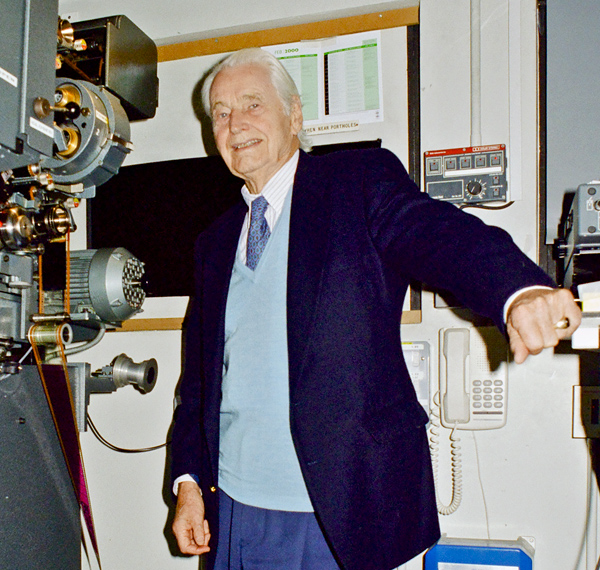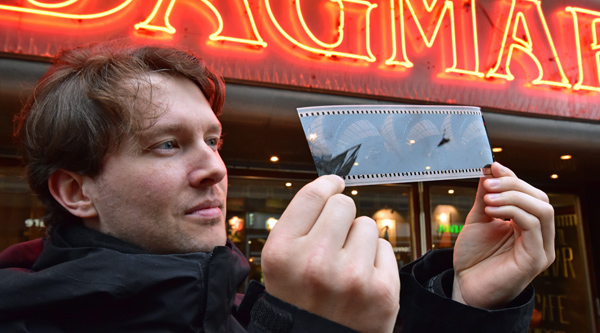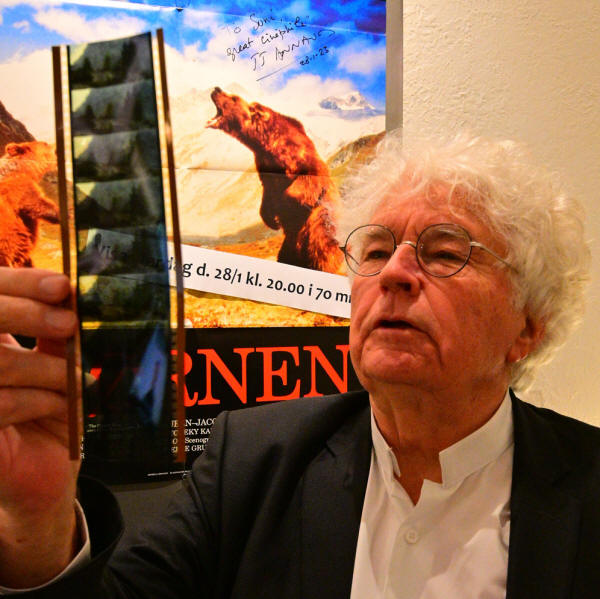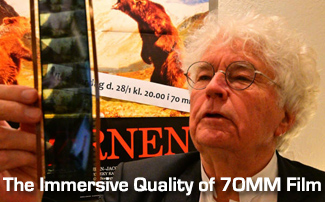The Immersive Quality of 70mm Film |
Read more at in70mm.com The 70mm Newsletter |
| Written by: - | Date:
26.08.2020 Updated: 01.07.2023 |
 Ken Annakin:
"For "Flying Machines"
I leaned to the Todd-AO system because the camera system was light, very
easy to operate and fast to load. You must remember that I was brought up
with 3-strip Technicolor where it took 11 minutes to load a camera". Picture by Thomas Hauerslev (2000) Ken Annakin:
"For "Flying Machines"
I leaned to the Todd-AO system because the camera system was light, very
easy to operate and fast to load. You must remember that I was brought up
with 3-strip Technicolor where it took 11 minutes to load a camera". Picture by Thomas Hauerslev (2000)"Those Magnificent men in their Flying Machines" / Ken Annakin "But as far as choosing Todd-AO for "Flying Machines" it was really the obvious choice. It was the biggest screen system at that time, biggest, and I knew I wanted to fill the screen with a great number of people and planes. What really is impressive now is seeing these tiny airplanes in a great big empty sky, and you only get that in 70mm." "Lawrence of Arabia" / Freddie A. Young "70mm film like anything has its advantages and disadvantages. It is particularly appropriate for those films that are set in locations of outstanding natural beauty. For example, it was certainly the right film for shooting "Lawrence of Arabia", where capturing the magnificence of the desert was so important..." "Oppenheimer" / Hoyte van Hoytema "IMAX is a format of spectacle and it's made for vistas and for the grandeur of it. But I got very curious to discover this as an intimate format. The face is like a landscape. There's a huge complexity and a huge depth to it. How can we get this camera closer to people? How can we get this medium to work also as a very intimate medium?" "Tenet" / Christopher Nolan “I’ve been working with the IMAX format for years now. It has this extraordinary power in terms of how deeply it can take the audience into the story. With a story as entertaining and fun as this one tries to be, we really felt that we wanted to wrap the movie around the audience and take them on a ride.” |
More in 70mm reading: Interview & People Chronological premiere list of major 70mm films "Death on the Nile" to be released in the UK in October, 2020 "Tenet" in the splendour of 7OMM |
 David
Findley: "...
65mm, you don't really notice it. I hope that people feel it. That was
always my intention." Picture: Thomas Hauerslev David
Findley: "...
65mm, you don't really notice it. I hope that people feel it. That was
always my intention." Picture: Thomas Hauerslev“Lay Me By The Shore” / David Findley "It's just the way that it [65mm] feels. Just kind of natural. For me, it was about how to place the camera and how to convey that there is a presence. I wanted to shoot on the larger format, which I felt sort of gives off this great sense of lucidity, you know? Like 65mm has ... no brain at all, ... which I love ... it feels like a window, or like a portal. In our case, for our film, kind of from the window, maybe from the beyond, on which to view our world or something like that. So conceptionally that was the idea, to use this large format in certain heightened moments." "The Master" / Paul Thomas Anderson “We started shooting with a 65mm Studio Camera and everything we were seeing started to feel very right. It gives you a wonderful, strong image, but more than the resolution or anything like that, it simply seemed to suit this story and these characters. Things could feel antique without feeling precious or a re-enactment of a particular style. It’s hard for me to describe it other than to say, it felt right.” "Dunkirk" / Christopher Nolan “The reason we were shooting on IMAX film, is that the immersive quality of the image is second to none. When you sit in the movie theatre, the screen disappears and you really get a very tactile sense of the imagery. That lends itself to incredible panoramas and large-scale action. But we’ve also found over the years that if you use it for more intimate situations, it creates an immediacy that’s very engaging. So our feeling was, if we could find a way to do it physically, the payoff would be well worth it.” |
|
 Jean-Jacques Annaud:
"The
best is 5.1 and in 70mm print, you have 6 tracks and they are magnetic and
the sound has a beautiful quality".
Picture: Thomas Hauerslev Jean-Jacques Annaud:
"The
best is 5.1 and in 70mm print, you have 6 tracks and they are magnetic and
the sound has a beautiful quality".
Picture: Thomas Hauerslev"The Bear" / Jean-Jacques Annaud " ... what makes a big difference is not only that 70MM has more definition than when you blow up from a 35mm negative, on 70MM the image has more definition because the positive is better. This is very technical but even if it is shot on 35mm, the 70MM print will be sharper, but the even larger difference is the magnetic sound. I remember I was very pleased with the sound. Very few people got to see it in a proper cinema well equipped for 70MM." "The Hateful Eight" / Quentin Tarantino “The thing about the roadshows that they used to do was that it made movies special. It wasn’t just a movie playing at your local theater. Some of them were musicals, some were big historical epics. They would do these big productions before the normal release of the film. You would get a big colorful program. It was a big presentation. They would play a Broadway show overture version of the soundtrack. If you’re going to shoot your movie and release it in 70mm, it’s really the way to go. Twenty-four frames a second flickering through a projector, creating the illusion of movement.” “Capturing this bleak Western landscape, capturing the snow, capturing the beauty of these locations would be perfect for 70mm. I believe that these big formats offer more intimacy. You can be closer to the characters. It could bring you closer and invade the intimacy of the characters in its bigness. I don’t think that it is a format that is only meant for travelogues.” "Chronos" / Ron Fricke "I remember when I was a little kid I always looked at the theater as a temple. Looking at films in Cinerama, these big widescreen films, I hadn’t a clue what they were about, but visually I was immensely moved by them. They gave me the sense that as viewers sit in the dark with their senses alert and defenses down, it’s a perfect opportunity to bypass their personalities and address their inner being." "I saw "To Fly" [In IMAX] and it was like a close encounter. I just couldn't believe the clarity, the concept of the film, a format that big, and that someone had actually done it. I never, ever got that out of my head once I saw the size of the image, the fidelity, and the fact that it was really a visual presentation." |
|
|
"Murder on the Orient Express" / Sir Kenneth Branagh "In our digital age, it's increasingly rare for films to be shot on celluloid, and mostly when they are, it's 35mm. We are shooting on 65mm. So, in crude terms, it's twice the size of the 35mm negative. It allows for a level of definition in the color and the range of tones and contrasts in the movie that, if you like film, some would argue, echoes more the experience of the human eye when viewing things. It essentially means, in layman's terms, that it looks sharper, richer, more colorful, and it feels like you're inside it. That's what 65mm does for me, and I wanted to take the audience onto the train. That's why we chose that format." "Hamlet" / Sir Kenneth Branagh "Pictures I've seen in that format are uniquely involving. They make you feel as though you can walk right into the landscape. I wanted the audience to smell and feel the atmosphere of the court, dripping with power, opulence and corruption. The increased sharpness of 65mm picks up everything; not just facial expressions, but any meaning in the actor's eyes is caught that much more clearly. It probes more deeply into the inner life of the character. It makes a significant impact on the power of the film, and therefore on its potential to reach a large audience. It gives a big picture feel to it, very much removed from watching films on small multiplex cinema screens or on video." "The glory of 70mm is the sharpness of the images it offers. With 70mm, we get a chance to go from what is essentially a personal, domestic story about a family and its' problems to the epic dimension that reflects the effects of those problems on the nation. We can go from the very intimate events in the court to the plains of northern Europe and see Fortinbras for the opportunistic leader he was, ready to invade with thousands of soldiers. 70mm is able to give that tremendous sweep so you feel the impact of the story, but it also has an incredible delicate touch, too." "I like to go to the movies. I like a large cinema with a packed house and a big picture. That to me is a very distinctive form of entertainment. And I wanted to be involved with that." |
|
 • Go to The Immersive Quality of 70mm Film |
|
| Go: back - top - back issues - news index Updated 22-01-25 |
